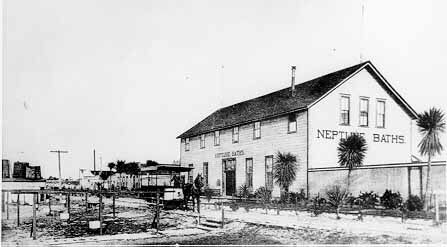Fred Swanton's boardwalk dates from 1904, but few know that he created his boardwalk on top of another, which makes it the oldest boardwalk in the West. Had it not been for a war and a divorce, the beachfront resort facilities might not have developed as early as they did.
Santa Cruz began as a major shipping port for raw materials and agricultural products. Then in 1862, the San Francisco Bay Association held its convention in Santa Cruz to escape the hysteria of Civil War mobilization in the city. The association returned with such glowing reports of scenic Santa Cruz that the city's resort potential was soon recognized.
The next year, Mary Liddell obtained a divorce from her husband, Capt. Timothy Dame, receiving custody of her younger son, Alfred. Mary and Alfred moved in with her mother, Elizabeth, who had turned her Beach Hill home into a boarding house after her husband's death in 1859.
The need for additional income led them to open the first hot saltwater baths west of the Mississippi in 1864, to serve visitors who found the icy waters of the bay a little too invigorating. This one-story structure on the beach with a waist-deep pool was called the Long Branch Baths, and grew to suit its name when in 1866, long canvas-topped dressing wings stretched out on either side. Other bathhouses that clustered around the river mouth had only bathtubs, but rented suits, umbrellas and beach tents, like the Long Branch.
In the midst of this swimming fad, the Leibbrandts came to Santa Cruz in 1863 and bought Beach Flats and waterfront lands. Johnnie Leibbrandt built the West's first hot saltwater plunge in 1868, on the waterfront east of today's "Neptune's Kingdom." Johnnie and David Leibbrandt were prodigious swimmers, known for Santa Cruz to Capitola open-water contests. They named the plunge "Dolphin Baths," with a large main-floor pool, and a fine upstairs ballroom. The steam generator that pumped and heated the saltwater also regaled bathers with steam-powered music from its poolside calliope.
Beach Street didn't exist then, and carriages drove on the beach itself. The Leibbrandts built the original boardwalk along the waterfront in 1868, for easier access to the baths. A gravel foundation for the 1876 railroad tracks was placed on the sands, and later fill-dirt flanking the tracks became Beach Street.
When Easterner A.F. Wheaton toured Santa Cruz in early 1879, he was so enraptured that he bought a beach front site -- where today's boardwalk casino stands -- and within a few months had erected palatial baths at a cost of $12,000. Reflecting his sense of propriety, the men and women were given separate pools to swim in, shielded from one another by a partition. Upstairs was a soda fountain and a large ballroom.
The gender-segregated pools only lasted five years. Capt. Fred Miller bought out Wheaton and unified the pools. Fred and his brothers, Ralph and Albert, were Santa Cruz natives and sons of a sea captain. Before building the bathhouse, Fred followed in his father's footsteps, becoming the youngest captain to operate out of San Francisco. He planted "California palms" (yuccas) and flowers around his baths.
The Neptune Baths, circa. 1888-92

The Leibbrandts kept abreast of the competition, buying up the riverside bathhouses, building Dolphin Park across the street from Dolphin Baths, and sponsoring the Dolphin baseball team. But in 1875 Johnnie Leibbrandt collapsed during a marathon swim, and that marked the onset of debilitating arthritis, which left him bedridden by 1887. And Miller was not adjusting as a landlubber. In 1889, he became captain of the steamer Maggie Ross, leaving his brothers to manage the bathhouse.
With both baths deprived of their original directors, it was only a month later that the Leibbrandts and Millers decided to consolidate as a single enterprise. Business grew to such a degree that their two bathhouses were not enough. In 1893, they received the backing of San Francisco millionaire A.P. Hotaling, the builder of the St. George Hotel who bid them spare no expense in creating the finest bathhouse possible. The new structure would stand halfway between the Dolphin and Neptune baths.
Local architect LeBaron Olive studied the best bathhouses on the coast and incorporated numerous features into his $25,000 creation. The "Eastlake" palace had a wide, gingerbread-trimmed beach veranda and stained-glass doors opening into the two-story plunge hall.

A "horseshoe balcony" contained a bandstand and bleachers, where one could observe swimmers on glass-lined slides, diving platforms or in gymnastic spectacles from ring and trapeze equipment over the pool.
The steamy air and sunny multicolored skylight made perfect conditions for the palms, flowers, and vines, giving a tropical ambiance. The pool was lighted with submerged colored lights, while a settling tank at one end produced a 5- foot-tall waterfall over the restaurant's observation windows. The restaurant was dominated by an elegant fireplace and had all the gingerbread and stained glass of a riverboat ballroom. A spiral staircase led to a rooftop, sea view observatory.
This article originally appeared in the San Jose Mercury News, July 13, 1993, p. 1B. Copyright 1993 Ross Eric Gibson. Reprinted by permission of Ross Eric Gibson. Photographs from the Santa Cruz Public Libraries' collection.
Disclaimer: It is the Library's intent to provide accurate local history information. However, it is not possible for the Library to completely verify the accuracy of individual articles obtained from a variety of sources. If you believe that factual statements in a local history article are incorrect and can provide documentation, please contact the Webmaster.